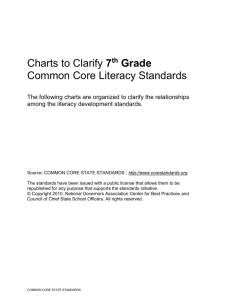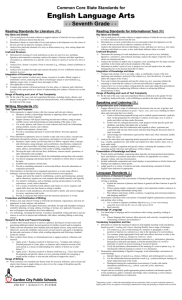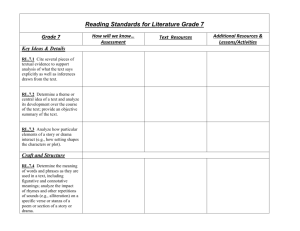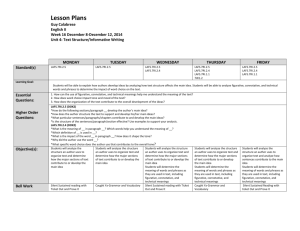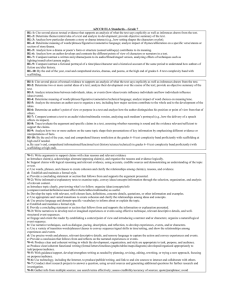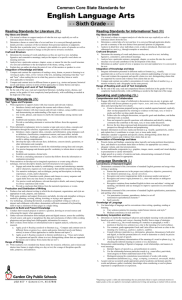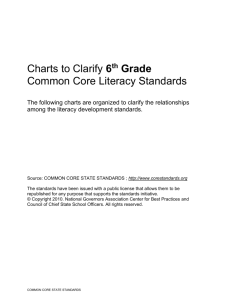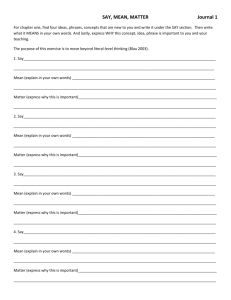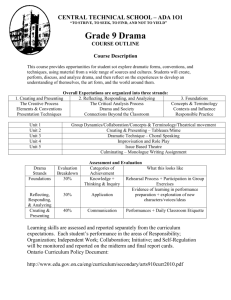7 th Grade ELA Pacing Guide
advertisement
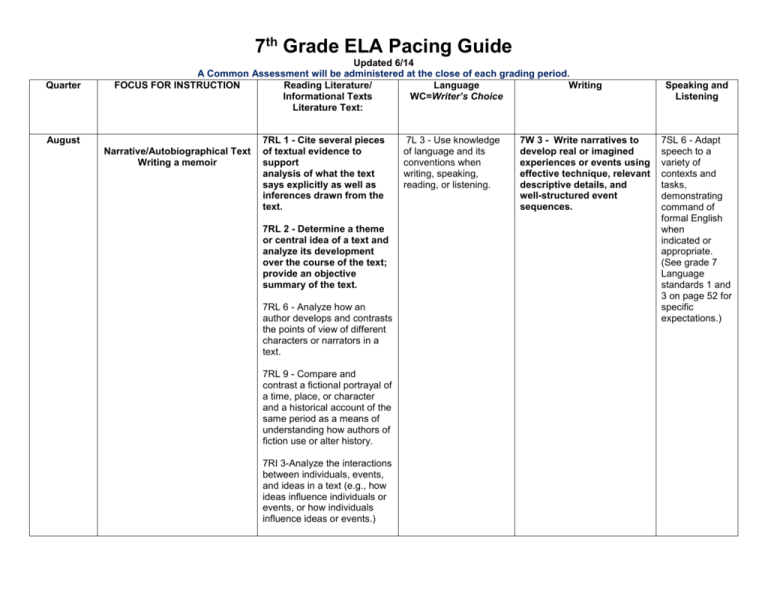
7th Grade ELA Pacing Guide Quarter Updated 6/14 A Common Assessment will be administered at the close of each grading period. FOCUS FOR INSTRUCTION Reading Literature/ Language Writing Informational Texts WC=Writer’s Choice Literature Text: August Narrative/Autobiographical Text Writing a memoir 7RL 1 - Cite several pieces of textual evidence to support analysis of what the text says explicitly as well as inferences drawn from the text. 7RL 2 - Determine a theme or central idea of a text and analyze its development over the course of the text; provide an objective summary of the text. 7RL 6 - Analyze how an author develops and contrasts the points of view of different characters or narrators in a text. 7RL 9 - Compare and contrast a fictional portrayal of a time, place, or character and a historical account of the same period as a means of understanding how authors of fiction use or alter history. 7RI 3-Analyze the interactions between individuals, events, and ideas in a text (e.g., how ideas influence individuals or events, or how individuals influence ideas or events.) 7L 3 - Use knowledge of language and its conventions when writing, speaking, reading, or listening. 7W 3 - Write narratives to develop real or imagined experiences or events using effective technique, relevant descriptive details, and well-structured event sequences. Speaking and Listening 7SL 6 - Adapt speech to a variety of contexts and tasks, demonstrating command of formal English when indicated or appropriate. (See grade 7 Language standards 1 and 3 on page 52 for specific expectations.) September Elements of a story, characters. Craft and Structure 7RL 2 - Determine a theme or central idea of a text and analyze its development over the course of the text; provide an objective summary of the text. 7RL 3 - Analyze how particular elements of a story or drama interact (e.g., how setting shapes the characters or plot). 7RL 6 - Analyze how an author develops and contrasts the points of view of different characters or narrators in a text. 7RI 3-Analyze the interactions between individuals, events, and ideas in a text (e.g., how ideas influence individuals or events, or how individuals influence ideas or events.) October Common Assessment 1Benchmark Mood, Tone and Suspense Introduction into Nonfiction text structures/features Craft and Structure 7RL 3 - Analyze how particular elements of a story or drama interact (e.g., how setting shapes the characters or plot). 7RL 6 - Analyze how an author develops and contrasts the points of view of different characters or narrators in a text. 7RI 1 - Cite several pieces 7 L 4 - Determine or clarify the meaning of unknown and multiplemeaning words and phrases based on grade 7 reading and content, choosing flexibly from a range of strategies. a. Use context (e.g., the overall meaning of a sentence or paragraph; a word’s position or function in a sentence) as a clue to the meaning of a word or phrase 7W 3 - Write narratives to develop real or imagined experiences or events using effective technique, relevant descriptive details, and well-structured event sequences. 7L 6 - Acquire and use accurately gradeappropriate general academic and domainspecific words and phrases; gather vocabulary knowledge when considering a word or phrase important to comprehension or expression. 7L 3 - Use knowledge of language and its conventions when writing, speaking, reading, or listening. 7 L 4 - Determine or clarify the meaning of unknown and multiplemeaning words and phrases based on grade 7 reading and content, 7W 3 - Write narratives to develop real or imagined experiences or events using effective technique, relevant descriptive details, and well-structured event sequences. 7SL2 – Analyze the main ideas and supporting details presented in diverse media and formats (e.g., visually, quantitatively, orally) and explain how the ideas clarify a topic, text, or issue under study. 7SL 6 - Adapt speech to a variety of contexts and tasks, demonstrating command of formal English when indicated or appropriate. (See grade 7 Language standards 1 and 3 on page 52 for specific expectations.) 7SL2 – Analyze the main ideas and supporting details presented in diverse media and formats (e.g., visually, quantitatively, orally) and explain how the ideas clarify a topic, text, or of textual evidence to support analysis of what the text says explicitly as well as inferences drawn from the text. 7RI 6 - Determine an author’s point of view or purpose in a text and analyze how the author distinguishes his or her position from that of others. November INFORMATIONAL TEXT STRUCTURE Informational Writing Research 7RI 1 - Cite several pieces of textual evidence to support analysis of what the text says explicitly as well as inferences drawn from the text. 7RI 2 - Determine two or more central ideas in a text and analyze their development over the course of the text; provide an objective summary of the text. 7RI 3-Analyze the interactions between individuals, events, and ideas in a text (e.g., how ideas influence individuals or events, or how individuals influence ideas or events.) 7RI 5 - Analyze the structure an author uses to choosing flexibly from a range of strategies. a. Use context (e.g., the overall meaning of a sentence or paragraph; a word’s position or function in a sentence) as a clue to the meaning of a word or phrase issue under study. 7SL 6 - Adapt speech to a variety of contexts and tasks, demonstrating command of formal English when indicated or appropriate. (See grade 7 Language standards 1 and 3 on page 52 for specific expectations.) 7L 5 - Demonstrate understanding of figurative language, word relationships, and nuances in word meanings. 7 L 4 - Determine or clarify the meaning of unknown and multiplemeaning words and phrases based on grade 7 reading and content, choosing flexibly from a range of strategies. 7W 2 - Write informative/explanatory texts to examine a topic and convey ideas, concepts, and information through the selection, organization, and analysis of relevant content. 7W6 - Use technology, including the Internet, to produce and publish writing and link to and cite sources as well as to interact and collaborate with others, including linking to and citing sources. 7W 7 - Conduct short research projects to answer a question, drawing on several sources and generating additional related, 7SL 3 Delineate a speaker’s argument and specific claims, evaluating the soundness of the reasoning and the relevance and sufficiency of the evidence. 7SL 4 - Present claims and findings, emphasizing salient points in a focused, coherent manner with pertinent organize a text, including how the major sections contribute to the whole and to the development of the ideas December Dramatic Transitions COMPARING AND CONTRASTING DIFFERENT MEDIA 7RL 3 - Analyze how particular elements of a story or drama interact (e.g., how setting shapes the characters or plot). focused questions for further research and investigation. 7W 8 - Gather relevant information from multiple print and digital sources, using search terms effectively; assess the credibility and accuracy of each source; and quote or paraphrase the data and conclusions of others while avoiding plagiarism and following a standard format for citation. 7L 3 - Use knowledge of language and its conventions when writing, speaking, reading, or listening. descriptions, facts, details, and examples; use appropriate eye contact, adequate volume, and clear pronunciation. 7W 9 - Draw evidence from literary or informational texts to support analysis, reflection, and research. 7SL 5 - Include multimedia components and visual displays in presentations to clarify claims and findings and emphasize salient points. 7W 2 - Write informative/explanatory texts to examine a topic and convey ideas, concepts, and information through the selection, 7SL 6 - Adapt speech to a variety of contexts and tasks, demonstrating command of formal English when indicated or appropriate. (See grade 7 Language standards 1 and 3 on page 52 for specific expectations.) 7SL2 – Analyze the main ideas and supporting details presented in diverse media Literary Unit 7RL 5 - Analyze how a drama’s or poem’s form or structure (e.g., soliloquy, sonnet) contributes to its meaning. 7RL 7 - Compare and contrast a written story, drama, or poem to its audio, filmed, staged, or multimedia version, analyzing the effects of techniques unique to each medium (e.g., lighting, sound, color, or camera focus and angles in a film). 7 L 4 - Determine or clarify the meaning of unknown and multiplemeaning words and phrases based on grade 7 reading and content, choosing flexibly from a range of strategies. organization, and analysis of relevant content. 7W 9 - Draw evidence from literary or informational texts to support analysis, reflection, and research. 7SL 6 - Adapt speech to a variety of contexts and tasks, demonstrating command of formal English when indicated or appropriate. (See grade 7 Language standards 1 and 3 on page 52 for specific expectations.) 7RL 9 - Compare and contrast a fictional portrayal of a time, place, or character and a historical account of the same period as a means of understanding how authors of fiction use or alter history. 7RI 7 - Compare and contrast a text to an audio, video, or multimedia version of the text, analyzing each medium’s portrayal of the subject (e.g., how the delivery of a speech affects the impact of the words.) January Common Assessment 2Benchmark Argumentative/Persuasive Writing Research and formats (e.g., visually, quantitatively, orally) and explain how the ideas clarify a topic, text, or issue under study. 7RL 3 - Analyze how particular elements of a story or drama interact (e.g., how setting shapes the characters or plot). 7L 3 - Use knowledge of language and its conventions when writing, speaking, reading, or listening. 7RL 6 - Analyze how an author develops and contrasts the points of view of different characters or narrators in a text. 7L 6 - Acquire and use accurately gradeappropriate general academic and domainspecific words and phrases; gather 7W 1 - Write arguments to support claims with clear reasons and relevant evidence. 7W6 - Use technology, including the Internet, to produce and publish writing and link to and cite sources as well as to interact and collaborate with others, including linking to and citing 7SL 3 Delineate a speaker’s argument and specific claims, evaluating the soundness of the reasoning and the relevance and sufficiency of 7RI 2 - Determine two or more central ideas in a text and analyze their development over the course of the text; provide an objective summary of the text. 7RI 3-Analyze the interactions between individuals, events, and ideas in a text (e.g., how ideas influence individuals or events, or how individuals influence ideas or events.) 7RI 5 - Analyze the structure an author uses to organize a text, including how the major sections contribute to the whole and to the development of the ideas 7RI 6 - Determine an author’s point of view or purpose in a text and analyze how the author distinguishes his or her position from that of others. 7RI 8 - Trace and evaluate the argument and specific claims in a text, assessing whether the reasoning is sound and the evidence is relevant and suffIcient to support the claims. 7RI 9 - Analyze how two or more authors writing about the same topic shape their presentations of key information by emphasizing different evidence or advancing different interpretations of facts. vocabulary knowledge when considering a word or phrase important to comprehension or expression. sources. the evidence. 7W 7 - Conduct short research projects to answer a question, drawing on several sources and generating additional related, focused questions for further research and investigation. 7SL 4 - Present claims and findings, emphasizing salient points in a focused, coherent manner with pertinent descriptions, facts, details, and examples; use appropriate eye contact, adequate volume, and clear pronunciation. 7W 8 - Gather relevant information from multiple print and digital sources, using search terms effectively; assess the credibility and accuracy of each source; and quote or paraphrase the data and conclusions of others while avoiding plagiarism and following a standard format for citation. 7SL 5 - Include multimedia components and visual displays in presentations to clarify claims and findings and emphasize salient points. 7SL 6 - Adapt speech to a variety of contexts and tasks, demonstrating command of formal English when indicated or appropriate. (See grade 7 Language standards 1 and 3 on page 52 for specific expectations.) February ARGUMENTATIVE/PERSUASIVE WRITING TEST WRITING 7RI 3-Analyze the interactions between individuals, events, and ideas in a text (e.g., how ideas influence individuals or events, or how individuals influence ideas or events.) 7RI 5 - Analyze the structure an author uses to organize a text, including how the major sections contribute to the whole and to the development of the ideas. 7RI 6 - Determine an author’s point of view or purpose in a text and analyze how the author distinguishes his or her position from that of others. 7RI 8 - Trace and evaluate the argument and specific claims in a text, assessing whether the reasoning is sound and the evidence is relevant and suffIcient to support the claims. 7RI 9 - Analyze how two or more authors writing about the same topic shape their presentations of key information by emphasizing different evidence or advancing different interpretations of facts. 7L 3 - Use knowledge of language and its conventions when writing, speaking, reading, or listening. 7L 6 - Acquire and use accurately gradeappropriate general academic and domainspecific words and phrases; gather vocabulary knowledge when considering a word or phrase important to comprehension or expression. 7W 1 - Write arguments to support claims with clear reasons and relevant evidence. that follows from and supports the argument presented. 7W 2 - Write informative/explanatory texts to examine a topic and convey ideas, concepts, and information through the selection, organization, and analysis of relevant content. REVIEW OF WRITING FOR PASS TESTING March Common Assessment 3Benchmark READING ACROSS GENRES/ WRITING DIFFERENT GENRES 7RL 2 - Determine a theme or central idea of a text and analyze its development over the course of the text; provide an objective summary of the text. 7RL 3 - Analyze how particular elements of a story or drama interact (e.g., how setting shapes the characters or plot). 7RL 4 -Determine the meaning of words and phrases as they are used in a text, including figurative and connotative meanings; analyze the impact of rhymes and other repetitions of sounds (e.g., alliteration) on a specific verse or stanza of a poem or section of a story or drama. 7RL 6 - Analyze how an author develops and contrasts the points of view of different characters or narrators in a text. 7RI 3-Analyze the interactions between individuals, events, and ideas in a text (e.g., how ideas influence individuals or events, or how individuals influence ideas or events.) 7RI 5 - Analyze the structure an author uses to organize a text, including how the major sections contribute to the whole and to the development of the ideas 7L 3 - Use knowledge of language and its conventions when writing, speaking, reading, or listening. 7L 6 - Acquire and use accurately gradeappropriate general academic and domainspecific words and phrases; gather vocabulary knowledge when considering a word or phrase important to comprehension or expression. 7W 3 - Write narratives to develop real or imagined experiences or events using effective technique, relevant descriptive details, and well-structured event sequences. 7W 9 - Draw evidence from literary or informational texts to support analysis, reflection, and research. April POETRY 7RI 6 - Determine an author’s point of view or purpose in a text and analyze how the author distinguishes his or her position from that of others. 7RL 2 - Determine a theme or central idea of a text and analyze its development over the course of the text; provide an objective summary of the text. 7RL 4 -Determine the meaning of words and phrases as they are used in a text, including figurative and connotative meanings; analyze the impact of rhymes and other repetitions of sounds (e.g., alliteration) on a specific verse or stanza of a poem or section of a story or drama. 7RL 5 - Analyze how a drama’s or poem’s form or structure (e.g., soliloquy, sonnet) contributes to its meaning. 7RL 9 - Compare and contrast a fictional portrayal of a time, place, or character and a historical account of the same period as a means of understanding how authors of fiction use or alter history. 7RI 3-Analyze the interactions between individuals, events, and ideas in a text (e.g., how ideas influence individuals or events, or how individuals 7L 3 - Use knowledge of language and its conventions when writing, speaking, reading, or listening. 7L 5 - Demonstrate understanding of figurative language, word relationships, and nuances in word meanings. 7L 6 - Acquire and use accurately gradeappropriate general academic and domainspecific words and phrases; gather vocabulary knowledge when considering a word or phrase important to comprehension or expression. 7W 3 - Write narratives to develop real or imagined experiences or events using effective technique, relevant descriptive details, and well-structured event sequences. 7SL2 – Analyze the main ideas and supporting details presented in diverse media and formats (e.g., visually, quantitatively, orally) and explain how the ideas clarify a topic, text, or issue under study. 7SL 6 - Adapt speech to a variety of contexts and tasks, demonstrating command of formal English when indicated or appropriate. (See grade 7 Language standards 1 and 3 on page 52 for specific expectations.) influence ideas or events.) May PASS REVIEW and PASS NOVEL 7RL 7 - Compare and contrast a written story, drama, or poem to its audio, filmed, staged, or multimedia version, analyzing the effects of techniques unique to each medium (e.g., lighting, sound, color, or camera focus and angles in a film). 7RL 9 - Compare and contrast a fictional portrayal of a time, place, or character and a historical account of the same period as a means of understanding how authors of fiction use or alter history. 7L 3 - Use knowledge of language and its conventions when writing, speaking, reading, or listening. 7 L 4 - Determine or clarify the meaning of unknown and multiplemeaning words and phrases based on grade 7 reading and content, choosing flexibly from a range of strategies. a. Use context (e.g., the overall meaning of a sentence or paragraph; a word’s position or function in a sentence) as a clue to the meaning of a word or phrase 7L 5 - Demonstrate understanding of figurative language, word relationships, and nuances in word meanings. Common Assessment 4Benchmark 7W 9 - Draw evidence from literary or informational texts to support analysis, reflection, and research. 7SL2 – Analyze the main ideas and supporting details presented in diverse media and formats (e.g., visually, quantitatively, orally) and explain how the ideas clarify a topic, text, or issue under study. 7SL 3 Delineate a speaker’s argument and specific claims, evaluating the soundness of the reasoning and the relevance and sufficiency of the evidence. 7SL 6 - Adapt speech to a variety of contexts and tasks, demonstrating command of formal English when indicated or appropriate. (See grade 7 Language standards 1 and 3 on page 52 for specific expectations.) All Year Standards 7RL 10 - By the end of the year, read and comprehend literature, including stories, dramas, and poems, in the grades 6–8 text complexity band proficiently, with scaffolding as needed at the high end of the range. 7RI 2 - Determine two or more central ideas in a text and analyze their development over the course of the text; provide an objective summary of the text. 7RI 4 - Determine the meaning of words and phrases as they are used in a text, including figurative, connotative, and technical meanings; analyze the impact of a specific word choice on meaning and tone. 7RI 10 - By the end of the year, read and comprehend literary nonfiction in the grades 6–8 text complexity band proficiently, with scaffolding as needed at the high end of the range. Revised 10-6-14 7L 1 - Demonstrate command of the conventions of standard English grammar and usage when writing or speaking. 7L 2 - Demonstrate command of the conventions of standard English capitalization, punctuation, and spelling when writing. 7W 4 - Produce clear and coherent writing in which the development, organization, and style are appropriate to task, purpose, and audience. (Grade-specific expectations for writing types are defined in standards 1–3 above.) 7W 5 - With some guidance and support from peers and adults, develop and strengthen writing as needed by planning, revising, editing, rewriting, or trying a new approach, focusing on how well purpose and audience have been addressed. (Editing for conventions should demonstrate command of Language standards 1–3 up to and including grade 7 on page 52.) 7W 10 - Write routinely over extended time frames (time for research, reflection, and revision) and shorter time frames (a single sitting or a day or two) for a range of discipline-specific tasks, purposes, and audiences 7SL 1 - Engage effectively in a range of collaborative discussions (one-on-one, in groups, and teacher-led) with diverse partners on grade 7 topics, texts, and issues, building on others’ ideas and expressing their own clearly.
